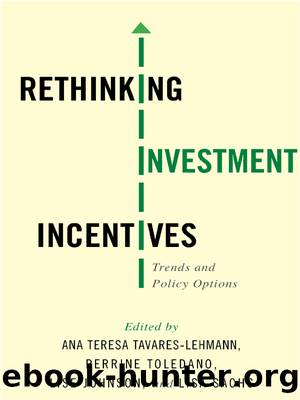Rethinking Investment Incentives by Ana Teresa Tavares-Lehmann

Author:Ana Teresa Tavares-Lehmann
Language: eng
Format: epub
Tags: BUS064020, Business & Economics/International/Taxation, BUS039000, Business & Economics/Economics/Macroeconomics
Publisher: Columbia University Press
Published: 2016-07-05T00:00:00+00:00
PART III
Designing Incentives Programs to Get Value for Money and Achieve Intended Goals
CHAPTER 8
A Holistic Approach to Investment Incentives
Louis Brennan and Frances Ruane
As the process of globalization took off in the 1990s, countries on every continent began to look to foreign direct investment (FDI) as a means to propel growth. For some countries, such as Singapore, the Netherlands, and Ireland, this belief in the growth-enhancing potential of FDI represented a further intensification of existing strategies; for others, such as Poland, Hungary, and Vietnam, it marked a completely new approach to development. Many countries have begun to view inward investment positively as a source of new capital, ideas, and access to networks and marketsâreflecting a change from an earlier stance that was suspicious of FDI as an exploiter of national resources and domestic markets. The move toward welcoming FDI has brought increased competition among countries, as they have begun actively to market their advantages to global enterprises. This competition has primarily taken the form of offering financial, fiscal, and regulatory incentives at the country, region (within a country), or city level.
The changed attitude toward FDI has led to a highly competitive environment for inward investment by global enterprises in key sectors. Locations (countries, regions, or cities) offer incentives packages to these enterprises, often taking account of what they see competitor locations offering. Locations differ in their offerings, depending on their stage of economic development, the extent of their existing engagement with global enterprises, their sectoral focus, and what specifically they seek to gain from the presence of these enterprisesâsuch as access to technology, global value chains, and scarce skills. As locations progress in terms of their development, their strategies regarding FDI tend to evolve. For example, locations at a relatively early stage of development, such as Morocco and Indonesia, may seek FDI that will help them to exploit their natural resources, as they do not have the capacity (skill/technology/capital) without FDI. At a later stage, these locations may seek FDI that will move them up the global value chains that can be key conduits for accessing skills, technologies, and markets. In this, they are following the recent patterns of more developed locations, such as European Union (EU) countries.
In the highly competitive global market for FDI, there are dynamic elements on both sides. On the one side, we have locations moving through their development cycles, with consequences for their motives and interests in potential FDI. At the same time, their political and economic relationships with their neighbors and other countries competing for similar investments are continuously changing. On the other side, the FDI enterprises themselves are always evolving as well, so the value of what an individual location actually offers to a mobile investor is not static. A consequence of this is that the time frame of the FDI investor will likely be very short relative to the development needs of the location that is competing for investment from it. A further complication in this market is the very significant asymmetry of
Download
This site does not store any files on its server. We only index and link to content provided by other sites. Please contact the content providers to delete copyright contents if any and email us, we'll remove relevant links or contents immediately.
| Corporate | International |
| Personal | Small Business |
Working for Yourself by J.D. (Nolo) Stephen Fishman(1815)
The Book On Tax Strategies for the Savvy Real Estate Investor by Amanda Han & Matthew MacFarland(1676)
Lower Your Taxes--BIG TIME! 2019-2020 by Sandy Botkin(1551)
The Secrets of Successful Financial Planning by Dan Gallagher(1492)
Small Business Taxes For Dummies by Eric Tyson(1492)
Working for Yourself by Stephen Fishman J.D. (Nolo)(1477)
Get What's Yours for Medicare by Philip Moeller(1363)
The Tax and Legal Playbook: Game-Changing Solutions to Your Small-Business Questions by Mark J. Kohler(1344)
Treasure Islands by Nicholas Shaxson(1300)
Plan Your Estate by Attorney Denis Clifford(1299)
101 Ways to Save Money on Your Tax--Legally! 2018-2019 by Adrian Raftery(1296)
475 Tax Deductions for Businesses and Self-Employed Individuals by Bernard B. Kamoroff(1293)
How to Pay Zero Taxes, 2019 by Jeff A. Schnepper(1288)
Unconventional Success: A Fundamental Approach to Personal Investment by David F. Swensen(1268)
The Power of Zero, Revised and Updated by David McKnight & Ed Slott(1255)
J.K. Lasser's Small Business Taxes 2013 by Barbara Weltman(1192)
Lower Your Taxes - BIG TIME! 2015 Edition: Wealth Building, Tax Reduction Secrets from an IRS Insider (Lower Your Taxes-Big Time) by Sandy Botkin(1121)
Showdown at Gucci Gulch by Alan Murray(1120)
The Border Guide by Robert Keats(1112)
